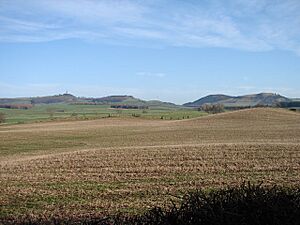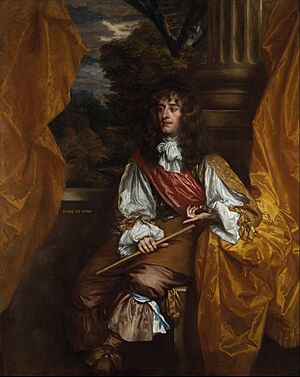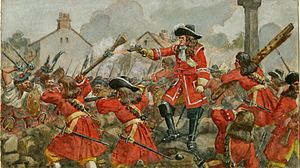Alexander Cannon (general) facts for kids
Quick facts for kids
Alexander Cannon
|
|
|---|---|
| Born | 1640 Kirkcudbrightshire, Galloway, Scotland |
| Died | after 1708 |
| Allegiance | |
| Service/ |
Army |
| Rank | Major general |
| Unit | 2nd English Regiment, Scots Brigade Queen Consort's Light Dragoons, later 3rd King's Hussars |
| Commands held | Jacobite army in Scotland, July to December 1689 |
| Battles/wars | |
Alexander Cannon (born 1640 – died after 1708) was a Scottish soldier. He lived in the late 1600s. He served in the armies of both William of Orange and James VII and II.
When King James VII and II lost his throne in 1688, Alexander Cannon stayed loyal to him. He went with James into exile. In July 1689, after Viscount Dundee died, Cannon became a Major-General for the Jacobite forces in Scotland. He was replaced by Thomas Buchan in early 1690. Cannon then served under Buchan until 1692. Both were allowed to travel safely to France that year. We don't know much about his life after that. He was still serving the Jacobites in 1708 and died sometime after that year.
Contents
Alexander Cannon's Early Life
Alexander Cannon was born in 1640. His family lived in the Stewartry of Kirkcudbright. This area is in the western part of Galloway, Scotland. His family was part of a small group of Scottish Catholics. At the time of his birth, the government in Scotland was run by Covenanters. They saw Catholic families like Cannon's as "disloyal."
We don't have many details about his early life. However, his family owned land at Arnmannoch and Knocklea. They likely traded cattle between Ulster (in Ireland) and Galloway. This might be why some writers called Alexander "Irish."
Alexander Cannon's Military Career
Alexander Cannon spent much of his time in the Scots Brigade. This was a military unit that served the Dutch under William of Orange. Even though it was called the "Scots Brigade," it had both English and Scottish regiments. In July 1680, Cannon became a Colonel of one of the English regiments.
In 1685, his regiment went to England. They were sent to help King James II stop a rebellion led by the Duke of Monmouth. The rebellion ended quickly, so the Brigade returned to the Netherlands. Cannon, however, stayed in England. In August 1685, he became a Lieutenant-Colonel in a new cavalry unit. This unit was called the Queen Consort's Light Dragoons.
In August 1687, Cannon became the Colonel of this regiment. He was with King James when William of Orange arrived in England. This event, in November 1688, is known as the Glorious Revolution. Many soldiers in the King's army, including most of Cannon's regiment, switched sides. Cannon remained loyal to King James and went into exile with him.
Fighting for King James
In March 1689, Cannon went with King James to Ireland. James hoped to win back his throne there. This started the Williamite War in Ireland. At the same time, a rebellion began in Scotland. It was led by Viscount Dundee. This Scottish uprising needed help from areas in County Antrim, Ireland. But it became harder to get help after the area of Kintyre was lost in May.
Dundee asked King James's Secretary of State for more troops and supplies. However, there were disagreements among James's supporters. They were unwilling to send too many resources from Ireland. Some wanted to replace Dundee with Thomas Buchan. But Buchan was needed for the siege of Derry in Ireland.
Instead, Alexander Cannon and 300 men were sent to Scotland. They crossed the Irish Sea in small boats. They landed at Duart on July 21. By July 26, they reached Blair Castle. They arrived just in time for the Battle of Killiecrankie. During this battle, Viscount Dundee was killed.
Cannon then took command of the Jacobite forces. However, some leaders, like Lochiel, thought he was not the best choice. Cannon was not familiar with Highland customs. He also could not speak Gaelic.
Challenges and Retreat
Winning at Killiecrankie did not greatly change the overall situation. In February 1690, Buchan and Lochiel asked King James for money, weapons, and more troops. These requests were not realistic. Also, the Scottish nobles were not giving enough support. They even asked for James's son, the Duke of Berwick, to lead the army.
The Jacobites needed access to a major port for supplies. But the Royal Navy controlled the Irish Sea. So, Cannon headed for Aberdeenshire. This area was a stronghold for Catholic and Royalist supporters.
An attempt to march on Edinburgh was blocked by Stirling Castle. The Jacobites could not capture it. They also lacked enough cavalry, which made them vulnerable in open areas. Even experienced leaders like Dundee found it hard to keep a Highland army together. After Killiecrankie, the army grew to 4,000–5,000 men. But this did not always make them stronger. It was much harder to supply such a large force. Many new recruits, like the MacGregors, joined mainly for raiding.
Cannon's options became limited when he could not reach Aberdeen. The Battle of Dunkeld on August 21 did not make much sense strategically. Highland fighting methods were not good for urban warfare. The Jacobites were pushed back with heavy losses. After this, the Jacobite army largely broke up. Many soldiers went home. Cannon and his remaining Irish troops spent the winter on the Island of Mull.
In February 1690, Thomas Buchan took command. But their force of 800 men was defeated at the Battle of Cromdale in May. Cannon, Buchan, and others managed to escape. They went back to Aberdeenshire, like Cannon had done the year before. They gathered a few hundred men. But they could not attack Aberdeen itself. The government army kept chasing them, and their forces slowly disappeared again.
Jacobite resistance ended when Kenneth Mackenzie, 4th Earl of Seaforth surrendered. Cannon and Buchan found safety first in Mull, then in Lochaber. They were protected by the MacDonald chief Glengarry. In January 1692, the Highland chiefs promised loyalty to the new government. Cannon and Buchan were given safe passes to leave Scotland. They landed in Le Havre, France, in April.
We know little about his later life. However, a Jacobite agent named George Lockhart wrote that Cannon was with him on a visit to Scotland in March 1708.
See Also
Images for kids





